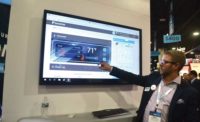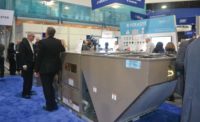CHICAGO — Danfoss had a fruitful and satisfying 2018 AHR Expo. Not only was its Turbocor® TTH/TGH High Lift Compressor named the winner of the 2018 AHR Expo Innovation Awards in the Green Building category, the company also took home the coveted Product of the Year award.
“Our foundation is a prior Innovation Award winner,” said John Galyen, president, North America, Danfoss. “It’s magnetic bearing, so it’s an oil-free compressor. It uses centripetal technology, and, up until this point, it was primarily targeted at water-cooled chillers. We’re very proud. For Danfoss, innovation is a cornerstone of our brand. This is the 28th time we have been recognized in the awards program, and the second time we have been awarded Product of the Year in just the past four years.”
Danfoss Turbocor TTH/TGH High Lift Compressors are optimized for air-cooled chiller and heat recovery applications. They feature oil-free, variable-speed, magnetic bearing operation for full- and part-load efficiency, low vibration and sound, a small footprint, and reduced maintenance.
In air-cooled chillers, the product can support operation at high ambient temperatures with pressure ratios as high as 6.2. The high-lift compressors are available in a nominal 325-kW (90-ton) model using R-134a or R-513A (TTH325) and a nominal 250-kW (70-ton) model using low-global warming potential (GWP) hydrofluroolefin (HFO)-1234ze (TGH250).
Danfoss also expanded the operating range of its Turbocor TT Series compressors to support low-lift applications, such as air-cooled heat pumps, enabling chiller manufacturers to expand their product offering to cover even more air-conditioning and process applications. The low-lift operating range allows chillers to start and operate at low condenser water temperatures that are common during cold ambient temperature conditions and gives manufacturers the flexibility to eliminate the use of expensive economizers on chillers.
“By expanding the use of low-GWP refrigerants, including the new low-GWP R-513A refrigerant option and the existing ultra-low-GWP HFO-1234ze refrigerant, Danfoss Turbocor TT Series compressors can continue to be a future-proof, environmentally friendly solution today that complies with evolving refrigerant regulations and standards around the world, including the European Union F-gas regulation,” said Jose Alvares, vice president, sales and marketing, Danfoss Turbocor Compressors. “And with the expanded low-lift capability, chiller manufacturers have the flexibility to benefit from the high-efficiency, variable-speed, oil-free operation of Turbocor TT Series compressors in even more air-conditioning applications.
“Danfoss is committed to taking a proactive approach to energy-efficient, sustainable technologies by offering multiple low-GWP refrigerant options,” Alvares continued. “The low-GWP refrigerant offering combined with innovative oil-free, magnetic bearing technology provide the best solution for our customers to meet environmental regulations today and in the future.”
Danfoss also showcased its Multi Ejector Solution™ during the AHR Expo. The Multi Ejector Solution unites two products — a Multi Ejector and Danfoss’ AK-PC 782A Rack Controller — into one solution that enables the broad deployment of transcritical CO2 refrigeration systems.
“Basically what we’re doing is taking a high pressure, and through a Venturi effect in the injector plates once they open, we’re raising the low pressure up to a medium pressure,” said Normand Masse, key account manager, Food Retail-Field Delivered Services, Danfoss. “In a normal compressor state, rather than having a pressure differential this big that the compressor has to raise, we’re bringing up the low pressure to more of a medium pressure state, so the compressor doesn’t have to pump as hard. This will replace one whole compressor on a rack by increasing that efficiency in a nonmechanical way. By reducing the amount of load on the rack, it will replace an entire compressor in some situations.”
As a refrigerant, CO2 has the lowest possible GWP, with a rating of “1,” which causes zero ozone depletion and is non-toxic and non-flammable. This means that both buildings and products can be cooled safely without negatively affecting climate. It is also exceptionally versatile and can be used in many different cooling applications, including commercial, industrial, and transport applications. The use of CO2 as a refrigerant was previously limited to cooler regions or required the use of complex, expensive systems. With the Danfoss Multi Ejector Solution, CO2 can now become a truly global solution.
“The warmer the temperature, the better this is,” Masse added. “It’s increasing efficiency by 40-50 percent in some cases. We have stores running now in locations with CO2 as far down as Austin and San Antonio, Texas. They’re actually finding the efficiencies are meeting, if not exceeding, expectations. It’s doing much better than expected. We will see this more in the future in warmer climates, maybe even in the tropics.”
Additionally, Danfoss also highlighted its VLT® HVAC Drives, which received Air-Conditioning, Heating, and Refrigeration Institute (AHRI) certification for variable frequency drives, confirming product performance based on rating standards prior to the expo.
Engineered specifically for the needs of HVAC pump, fan, and compressor applications, VLT HVAC Drives enable optimized process control to reduce energy consumption, meet environmental targets, and significantly reduce costs in today’s buildings. Featuring an easy-to-use design with built-in intelligence, the drives are fast and cost-effective to commission and ensure maximum uptime even in harsh environments. A compact design and efficient heat management system make VLT HVAC Drives ideal for applications where space is restricted. With the intelligence built into the drive to precisely maintain the exact flow required using the four auto-tuning, multi-input, multi-control PID’s, users experience the control and comfort expected.
After a successful 2017, Danfoss remains optimistic heading into 2018, particularly as the company continues to invest in the North American market, Galyen noted.
“We recently invested to expand our production of plate and frame heat exchanger capabilities in Louisville, Kentucky, and continue to invest in heat exchanger technology, including brazed plate, microchannel, and plate and frame heat exchangers,” Galyen said. “We also completed the construction and qualification of our new Application Development Center in Tallahassee, Florida — and we are already actively supporting our customers and our own R&D [research and development] efforts in the engineering of next-generation rooftop units and chillers at the facility. We also established, in 2017, a new state-of-the-art cleanroom production factory in Utica, New York, to package silicon-carbide (SiC) power modules to help meet the global demand for smaller, faster, and more efficient devices and support industry trends toward electrification and storage.
“Looking ahead, Danfoss remains committed to helping deploy the proven solutions that are available today to improve performance, efficiency, reliability, and comfort, including advanced controls, compressors, variable-speed technologies, heat exchangers, and low-GWP refrigerant solutions,” he continued. “But, we are also engaged in the changing landscape of federal and state regulations around refrigerants and minimum efficiency requirements as well as emerging trends toward electrification, storage, whole building system integration, and the smart store.”
Publication date: 2/26/2018










